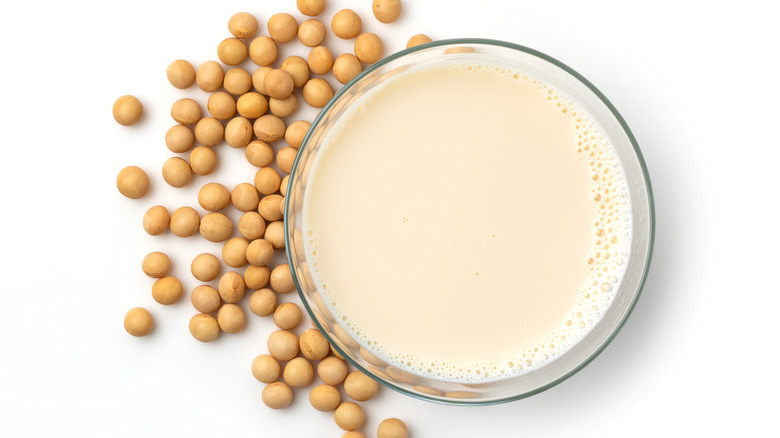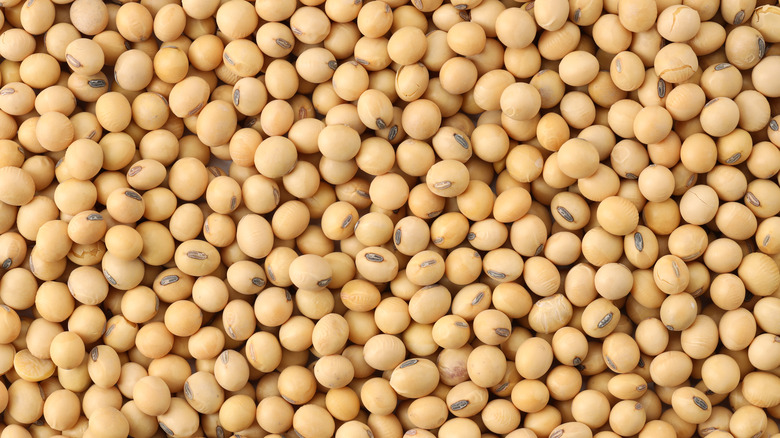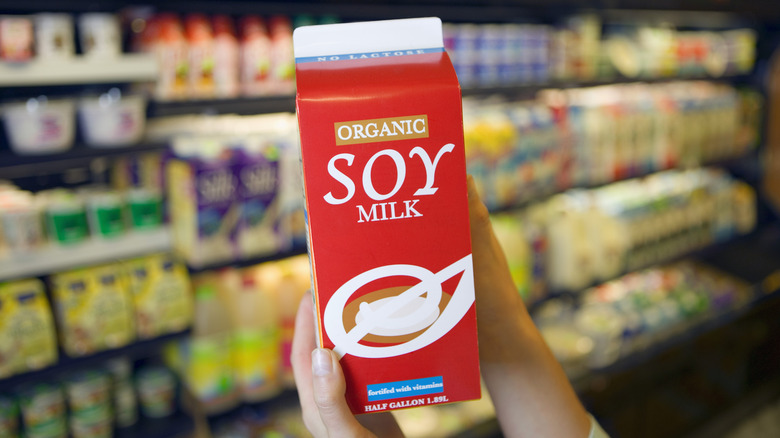How Soy Milk Shook Its Bad Reputation In The 1990s
Oat milk, almond milk, hemp milk, cashew milk — the list of non-dairy alternatives goes on and on. Within the last decade or so, it seems milk derived from a different source has been rapidly appearing everywhere: At your local market on the daily, in the lattes of Starbucks customers, and even in the headlines a la "Succession" star James Cromwell, per the Los Angeles Times. But despite the array of options the average 21st-century consumer has when it comes to plant-based milk nowadays, we can't forget the milk that started it all — soy milk.
According to the Soy Info Center, the first mention of the use of soy milk was documented in China in the mid-14th century. Much later on, the United States jumped on board the soybean train in the 1980s; though, to be fair, it had been on the shelves of Chinese grocers for 60 years by then. Unfortunately, soy has been vilified in some circles despite studies such as this one from McGill University, which deemed soy the healthiest of all the milk alternatives. So why did soy milk's reputation need help? The answer may be in figuring out why soy milk had public image problems to begin with.
Bad research travels fast
The confusion about soy came from research on isoflavones — which are considered phytoestrogens, a type of plant nutrient — performed using animals during the 1990s. These studies warned consumers about the dangers of soy acting as an estrogen disruptor and linked it to cancer development, according to the American Cancer Society. Some of the confusion among the general public comes from a misunderstanding between estrogen and phytoestrogen. Estrogen is a female reproductive hormone present in both men and women that, at certain levels, can contribute to cancer, per the National Cancer Institute. Plants, like soybeans, produce phytoestrogen — a completely different compound, and one that has been proven to protect against certain cancers and combat a host of other health problems (via Healthline).
It wasn't until the late 1990s that the reputation of soy started to change in the minds of consumers, as Environmental Health Perspectives notes. Once the studies were released showing the safety of soy consumption — and, more importantly, the health benefits of consuming soy — the medical community caught wind of the results, and public opinion began to change.
How to enjoy the soy
Soy milk should only contain two ingredients: organic non-GMO soybeans and water. With that in mind, it's important to read labels and know the facts before buying. While some non-organic foods are considered safe to consume, non-organic GMO soy isn't one of them. According to Pacific Standard Magazine, genetically modified (GMO) soybeans absorb pesticides more readily than other crops, so they should be avoided.
Soy's bad reputation has been hard to shake, with some breast cancer survivors continuing to believe they shouldn't consume soy. The truth is that the maligned soybean has been proven to be effective in preventing a recurrence of breast cancer, per Nutrition Facts. And while a true soy allergy does exist, only 1 in 2,000 people are allergic — four times less than those allergic to milk, according to another article on Nutrition Facts. So, suffice it to say: Dump the dairy, order that grande soy latte, and proudly embrace your soy boy status. Soy is here to stay.


